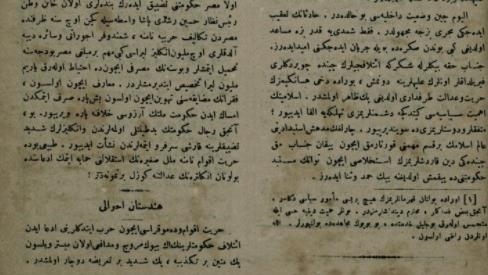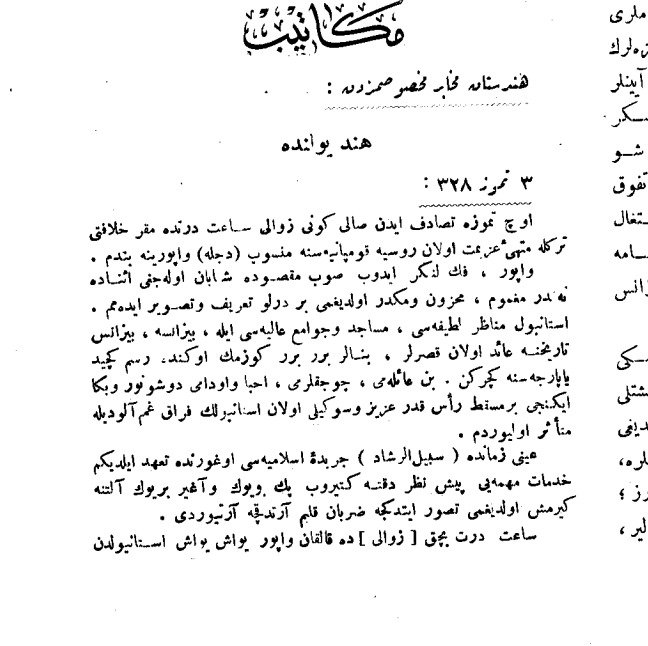OPINION - Ottoman-era Turkish newspapers endorse Hindu-Muslim unity in India
A look at coverage of Ottoman-era newspapers shows humanist Turkish worldview towards India, appreciating its diversity and values

*The writer is an assistant professor at Ankara Yildirim Beyazit University's International Relations Department.
ANKARA
The digitized form of newspaper files of the late Ottoman Empire era, made public by the Turkish government and Turkish non-governmental organizations, adds new knowledge on Ottoman society, culture, and politics.
Among many late Ottoman newspapers, the Sebilurresad is one of the most popular publications which had closely covered and followed Indian affairs. The fortnightly magazine was first started in 1908 as Sırat-ı Mustakim by Ebul‘ula Zeynelabidin and H. Esref Edip with Mehmet Akif as the chief editor.
Forced several times to stop publication or change its name, it became Sebilurresad in 1912. Mehmet Akif, who actively participated in Turkey's national struggle, and would, later on, write the national anthem of Turkey, was the editor in chief of Sebilurresad. The editorial team of Sebilurresad had widely traveled to South Asia, the Middle East, and Europe to mobilize awareness and support for Turkey.
When Sebilurresad was started, British-Ottoman relations had already started declining. Parts of Turkish territories were under the control of allies after World War I.
The status of the two holy mosques of Mecca and Medina was the biggest source of disquiet for the Muslim community worldwide, including the large Muslim population in the Indian subcontinent. They had already set up an organization like Anjuman Khuddam-e-Kaba (Assembly of Servants of Kaba) and the Indian Khilafat Movement, to demand the protection of Islam's holiest sites.

Long list of political issues concerning India, Turkey
When the correspondents of Sebilurresad started covering Indian affairs, they found a long list of political issues that concerned the future of India and Turkey.
Abdurreshid Ibrahim, SM Tevfik, Ahmed Halil, Ashraf Edip, Omer Riza Dogrul can be seen among the frequent contributors on Indian affairs in Sebilurresad. The pan-Asianist Abdurresid İbrahim had traveled to India, en route to Japan in 1908 and had published his observations both in the Sirat-i Mustakim" and then in the Sebilurresad, when the name was changed.
In one of his letters from India, he writes: "If I say India is the world's most sacred place, it will not be wrong. Prophet Adam is said to have landed near India in Srandip (Sri Lanka). Abdirresid Ibrahim's Arabic biographer Salim Muhammad underlines his suggestion that India's independence had to be fought together by both Muslims and Hindus.
Abdurresid Ibrahim wrote a long article in 1922 to analyze India's independence struggle. In this article, the Ahmedabad session of the Indian National Congress in 1921 got his attention, for it was held under its Muslim President, Hakim Ajmal Ahmad Khan. He found this a strong message of unity of all Indians against British rule.
In this article, he wrote: "India is a country of the greatest diversity of religion, languages, and faiths; however, their disunity will spoil their dreams of independence. The unity which Indians of all faiths had shown in the Indian Khilafat Movement was an example."
After Abdurresid Ibrahim, SM Tevfik had extensively traveled to Indian cities from 1912-1913 and published his travelogue in 37 parts titled Hind Yolunda (On Way to India).
Sebilurresad is said to be a magazine of conservative late Ottoman politicians. This makes it a unique understanding of the complex relationship between Islam, nationalism, and Muslim identity. Their generous admiration for Indian leaders and India's Islamic scholars, including Rabindranath Tagore, Mahatma Gandhi, Maulana Abul Kalam Azad, Muhammad Ali Jauhar, Shaukat Ali, Shibli Nomani, and many others speaks volumes of the unique understanding.
Praise for Maulana Azad
Sebilurresad, while covering Indian affairs, had no clue that India could ever be partitioned some two decades later on religious lines. For them, Maulana Azad was not only a politician but also a great Islamic thinker who had inspired a new awareness among global Muslims. The articles and speeches of Maulana Azad were immediately translated and published in Sebilurresad and other magazines. In this period, the magazine started covering Indian affairs more actively.
The famous speech of Maulana Abul Kalam at a court in the city of Calcutta (now Kolkata) received much attention and was published in Sebilurresad and other magazines. His address was translated into Ottoman Turkish and was later published in book form. In addition, events from small Indian cities, like Rampur, Lucknow, Hamirpur, and other citizens, got the journal's attention.
From 1908 to1925, around 500 articles, news items, or translations of India-related materials were published in Sebilurresad. Among the earliest articles are the reports of Abdurresid Ibrahim, who had visited Bombay, Hyderabad, and other cities in 1908. Abdurresid Ibrahim was the first Turkish journalist and activist who had introduced his Turkish readers to Indian political affairs. His writings helped the Ottoman politicians understand Indian politics more closely, and, as a result, the Ottoman/Turkish interest in Indian affairs increased rapidly.
In these years, Indian Muslims were helped with the Hijaz Railway project of the Ottoman government and the construction of ports in Turkey. Indian activities in Iran found special attention in the newspaper.
There is a possibility that Abdurresid Ibrahim had also met Rabindranath Tagore and Subash Chandra Bose during his stay in Japan.
Since the start of World War I in 1914, the magazine covered affairs related to the War, especially the position of Indian Muslims. The issue of British politics towards the Ottoman Khilafat and the two Holy Mosques of Mecca and Medina received special attention. In that tumultuous time, Khilafat Movement had also started. In 1924, when Rabindranath Tagore reached Japan, Abdurresid Ibrahim was already there, and he closely followed the lectures of Tagore and published his reports about Tagore's lectures in four parts.
Khilafat movement finds coverage
One of the most widely covered subjects in these papers is India's independence struggle. Then the Khilafat movement found significant coverage in these papers. The subjects of India's history, culture, and society were also widely covered in many issues of Sebilurresad. Japanese politics, Pan-Asianism, Hijaz railway, British policy towards Mecca and Medina, centers of Islamic scholarship in India like Deoband, Nadwatul Ulama, and works of Maulana Abul Kalam Azad, and Allama Shibli Numani found significant mention.
The travel of Raja Mahendra Pratap Singh and the results of Tagore also received their attention. Interestingly, news from small towns like Azamgarh, Rampur, Hamirpur, Lucknow, Kanpur has also got the magazine's attention. Even the prevalence of Perso-Arabic traditional medicine known as Unani medicine in India also received the attention of SM Tevfik, who published a long report about its prevalence in India in issue number 257 of 1911.
Among political issues, the Indian Khilafat Movement, Indian National Congress, Gandhi, Azad, British conferences about India received much attention. According to a report published in Sebilurresad's issue number 528 of 1920, the Indian Khilafat Movement offered to mediate between the Arabs and Turks to sort out their differences.
In the issues of 551-552, detailed articles on Muhammad Ali Jauhar and Shaukat Ali, famously known as Ali Brothers, were published. The report also noted that Ali Brothers had a huge support of all Muslims and non-Muslims in their anti-British politics. For Ali Brothers, like Maulana Azad, the support for the Ottoman Khilafat in the time of the British occupation of Istanbul and other Islamic holy places, Mecca and Medina, was not different from their struggle against British colonial rule in India.
Interesting expectations
In an article published in the issue of 286, in February 1913, about Indian Muslims’ expectations from Turkey, the visiting correspondent of the Sebilurresad, SM Tevfik, includes two interesting expectations. One Ottomans should closely observe and learn from the rise of Japan. Second, Turkey should establish close trade relations with India and all Asian countries, even if the trade volume is small.
In the issue of 292, in 1913, Tevfik observed that the failure of the first war of India’s independence in 1857 had made the Indian masses more sensitive and aware, especially Hindus.
They found that modern education is necessary to compete with the West. For these reasons, Hindus in Calcutta opened schools and colleges and sent their children to Europe for advanced education in science and mathematics.
He writes that the nationalist sentiments are getting stronger among Hindus, to the extent that a Hindu working with any British office is publicly laughed at and humiliated. Those who work for British authorities now hide their identity or resign from their jobs.
These nationalist sentiments are reflected in their political struggle in the Indian National Congress. This year, they chose a Muslim, Syed Muhammad Khan as their president at the Karachi session of 1913. In the issue of July 11, 1911, the magazine introduced a Paris-based magazine Vande Matram founded by freedom fighter Madam Bhikaji Kama.
In a report on the happiness of Indians over the return of Edirne back to the Ottoman rule, SM Tevfik introduced the Vande Matram magazine and translated the motto of the magazine which read: "Life is nothing without independence. There is no difference between the dead people buried in their graves and the people without freedom."
On Hindu-Muslim riots
Tevfik found that any Indian in possession of this magazine would have to lose everything.
The issue of July 25, 1913, carefully covered the Kanpur riots. The writers said that the British authorities had misused the communal violence to weaken the Hindu-Muslim unity against British colonialism. SM Tevfik noticed that Hindu and Muslim businessmen in Madras (Chennai) had unitedly set up a chamber of commerce.
After reporting from many cities, SM Tevfik announced that he would write a detailed introduction of Hinduism to Turkish readers. In most reports, Sebilurresad always underlined the unity among various Indian religions for the sake of their common political future. The coverage of India in the magazine shows Turkey’s humanist worldview towards Indian affairs by appreciating India’s diversity and its leaders’ efforts to make India a country of pluralist ideas and values.
**Opinions expressed in this article are the author's own and do not necessarily reflect the editorial policy of Anadolu Agency.


